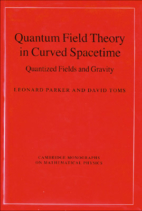Quantum Field Theory in Curved Spacetime: Quantized Fields and Gravity
By Leonard Parker and David Toms
Cambridge University Press
Hardback: £48 $83 E-book: $64
Exact Space–Times in Einstein’s General Relativity
By Jerry B Griffiths and Jirˇí Podolský
Cambridge University Press
Hardback: £80 $129 E-book: $100

Long ago, more or less immediately after Einstein’s formulation of general relativity, one of the dreams of physics was to understand why flat space–time is so special. Why are quantum mechanics and field theory formulated in flat space while their curved-space analogues are sometimes ill defined, at least conceptually? Can we hope, as Richard Feynman speculated, to quantize gravity in flat space–times and then construct all of the most complicated geometries as coherent states of gravitons?
The dreams of a more coherent picture of gravity and of gauge interactions in flat space are probably still there, but nowadays theorists invest a great deal of effort in understanding the subtleties of the quantization of fields, particles, strings and (mem)branes in geometries that are curved both in space and in time. Cambridge University Press was one of the first publishers to voice these attempts with the classic Quantum Fields in Curved Space by N B Birrel and P C W Davies, which is now well known to many students since its first edition in 1982. Leonard Parker (distinguished professor emeritus at the University of Wisconsin) and David Toms (reader in mathematical physics and statistics at the University of Newcastle) were both abundantly quoted in the book by Birrel and Davies and they have now published Quantum Field Theory in Curved Spacetime, also with Cambridge. While readers of Birrel and Davies will certainly like this new book, newcomers and students will appreciate the breadth and the style of a treatise written by two well known scientists who have dedicated their lives to the understanding of the treatment of quantum fields in a fixed gravitational background.
The book consists of seven chapters spread evenly between pure theory and applications. One of its features is the attention to the introductory aspects of a problem: students and teachers will like this aspect. The introductory chapter reminds the reader of various concepts arising in field theory in flat space–time, while the second chapter introduces the basic aspects of quantum field theory in curved backgrounds. After the central chapters dealing with useful applications (including the discussion of pair creation in black-hole space–times) the derivation of effective actions of fields of various spins is presented, always by emphasizing the curved-space aspects.

A rather appropriate companion volume is Exact Space-Times in Einstein’s General Relativity by Jerry Griffiths and Jiří Podolský, published by Cambridge in late 2009. Here, the interested reader is led through a review of the monumental work performed by general relativists over the past 50 years. The book also complements (and partially extends) the famous work by Dietrich Kramer, Hans Stephani, Malcolm MacCallum and Eduard Herlt, Exact Solutions of Einstein’s Field Equations, first published, again by Cambridge, in 1980.
Like its famous ancestor, the book by Griffiths and Podolský will probably be used as a collection of exact solutions by practitioners. However this risk is moderated to some extent by a presentation in the style of an advanced manual of general relativity (GR). The 22 chapters cover in more than 500 pages all of the most important solutions of GR. After two introductory chapters the reader is guided on a tour of the most important spatially homogeneous and spatially inhomogeneous, four-dimensional background geometries, starting from de Sitter and anti-de Sitter space–times but quickly moving to a whole zoo of geometries that are familiar to theorists but which may sound rather arcane to scientists who are not directly working with GR.
Both books reviewed here can also be recommended because they tell of the achievements of a generation of theorists whose only instruments were, for a good part of their lives, a pad of paper and a few pencils.





